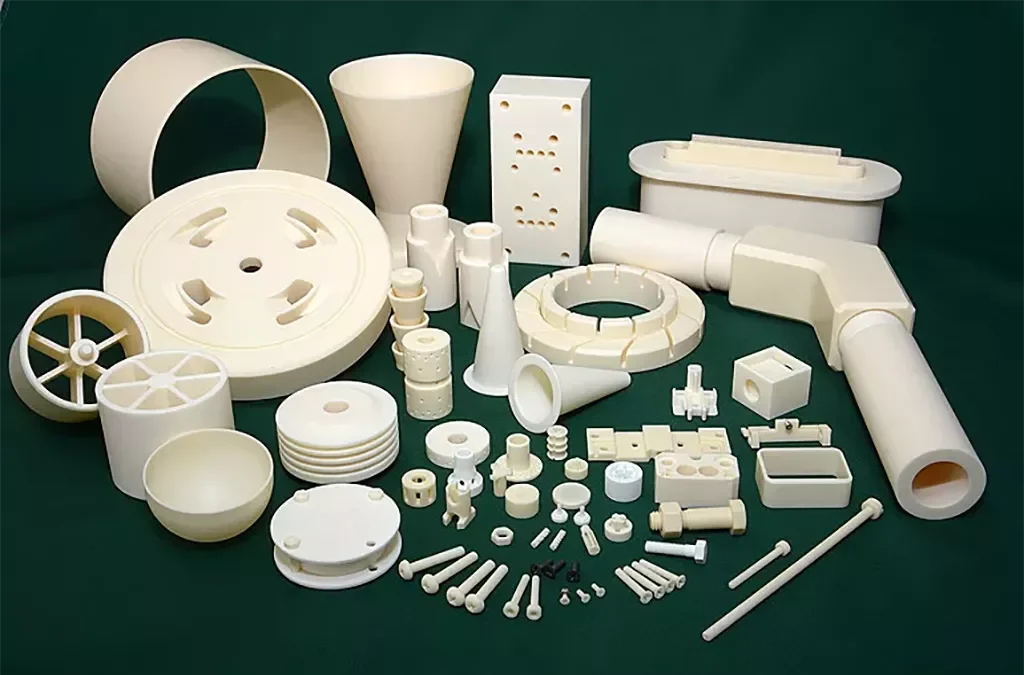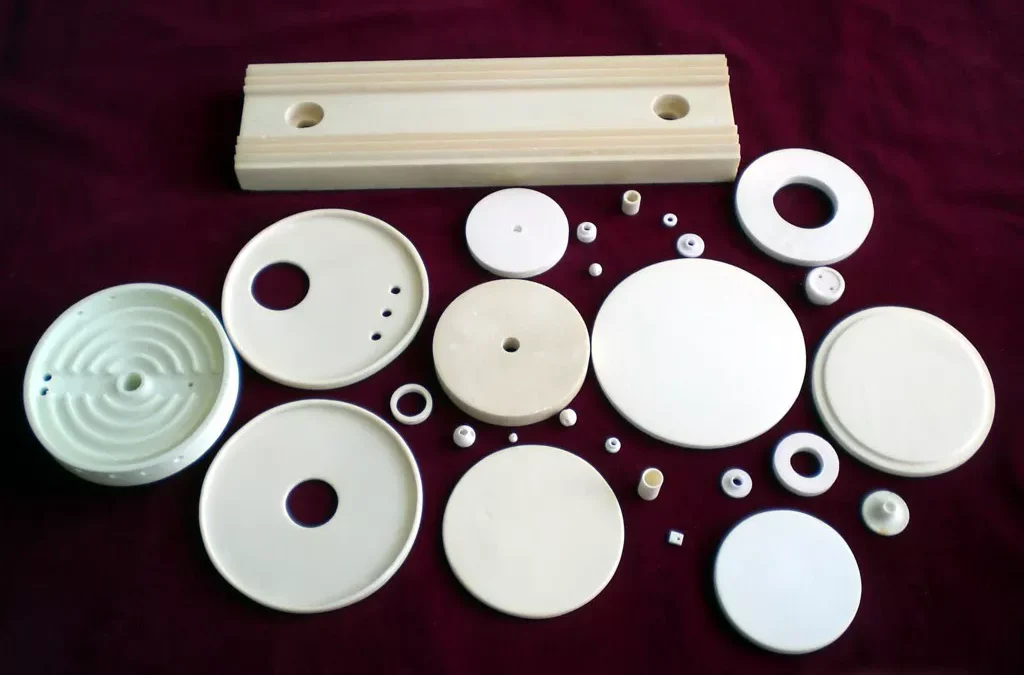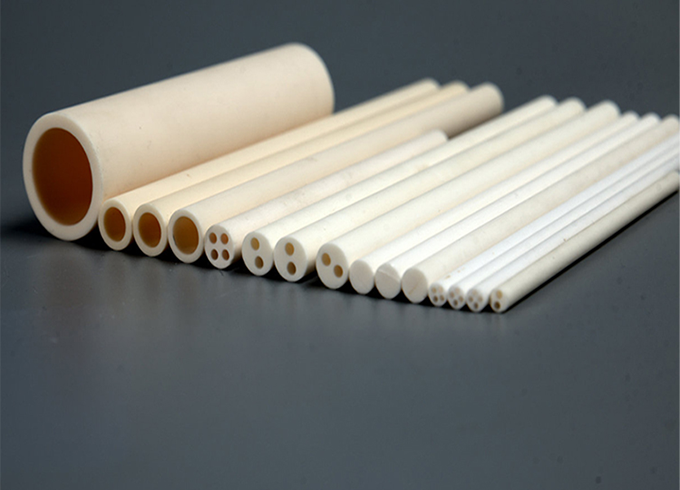Alumina ceramic is a ceramic material based on aluminum oxide (Al2O3) and is used in thick film integrated circuits. Alumina ceramics have good conductivity, mechanical strength and high temperature resistance. It should be noted that ultrasonic cleaning is required. Alumina ceramic is a widely used ceramic. Because of its superior properties, its application in modern society has become more and more extensive, meeting the needs of daily use and special properties.


Alumina ceramics are divided into two types: high purity type and ordinary type.
High-purity alumina ceramics are ceramic materials with an Al2O3 content of more than 99.5%. Due to their high sintering temperature of 1650-1990℃
Ordinary alumina ceramics are divided into 99 porcelain, 95 porcelain, 90 porcelain, 85 porcelain and other varieties according to the Al2O3 content. Sometimes those with an Al2O3 content of 80% or 75% are also classified as ordinary alumina ceramic series. Among them, 99 alumina porcelain is used to make high-temperature crucibles, refractory furnace tubes and special wear-resistant materials, such as ceramic bearings, ceramic seals and water valves; 95 alumina porcelain is mainly used for corrosion-resistant and wear-resistant parts; 85 porcelain Because part of talc is often mixed into it, the electrical properties and mechanical strength are improved. It can be sealed with molybdenum, niobium, tantalum and other metals, and some are used as electric vacuum devices.Alumina ceramics are divided into two types: high purity type and ordinary type.
High-purity alumina ceramics are ceramic materials with an Al2O3 content of more than 99.5%. Due to their high sintering temperature of 1650-1990℃
Ordinary alumina ceramics are divided into 99 porcelain, 95 porcelain, 90 porcelain, 85 porcelain and other varieties according to the Al2O3 content. Sometimes those with an Al2O3 content of 80% or 75% are also classified as ordinary alumina ceramic series. Among them, 99 alumina porcelain is used to make high-temperature crucibles, refractory furnace tubes and special wear-resistant materials, such as ceramic bearings, ceramic seals and water valves; 95 alumina porcelain is mainly used for corrosion-resistant and wear-resistant parts; 85 porcelain Because part of talc is often mixed into it, the electrical properties and mechanical strength are improved. It can be sealed with molybdenum, niobium, tantalum and other metals, and some are used as electric vacuum devices.
Scenes to be used
Made of materials with good insulation, it is mainly used to separate the different poles of the temperature measuring element to avoid interference between the two poles or contact short circuit, so as to ensure accurate temperature measurement.
Instructions
When using, just insert the two poles of the temperature measuring element into different holes in the same direction. After installation, protect it with a protective tube set.
Material classification
Depending on the temperature of the thermocouple, the alumina content used is also different, such as 99.7 porcelain (corundum), 99 porcelain (corundum), 95 porcelain (corundum), 85 porcelain (high alumina porcelain), 75 porcelain (mullite porcelain) ), chemical porcelain (40 aluminum), the higher the alumina content of the above materials, the higher the operating temperature. The highest aluminum content is used vertically at 1710 degrees Celsius, and the lowest aluminum content is used at 1100 degrees Celsius.
Size
The conventional size of the insulating tube is from 1mm to 8mm in outer diameter. The holes are divided into single holes, double holes, four holes and multiple holes. The minimum hole diameter is 0.5mm and the maximum length is 2500mm. Other sizes can also be made according to user requirements.

We are a professional custom-made industrial alumina/zirconia/aluminum nitride ceramic manufacturer in China, if you are interested in this, please contact us.
FAQ
Can you provide samples for me to test? How much does it cost?
We strive to provide ceramic samples that closely meet your requirements to the best of our abilities.
The samples are completely free, but you need to pay the freight.
For samples with unique shapes that require custom molds, we are open to discussing the mold cost in order to accommodate your specific needs.
We don’t know which material of ceramic we need, what should we do?
No worries! Please provide us with more details about your requirements, such as the intended use, desired properties, and any specific characteristics you're looking for.
With these information, our team can guide you in selecting the most suitable ceramic material for your needs.
We are concerned about the quality of the product we ordered.
We understand your worries and we maintain stringent quality control standards as following:
| Test Standard | Testing Dimension | Pass Rate | Standard Range |
|---|---|---|---|
| Appearance Inspection | Quantity and Severity of Defects | ≥ 97.3% | Determined by AQL standard |
| Dimensional Inspection | Size Accuracy and Consistency | ≥ 98.1% | Determined by ISO 9001 standard |
| Density Testing | Material Density | ≥ 97% | Determined by ASTM C20 standard |
| Hardness Testing | Surface Hardness | ≥ 98.2% | Determined by ISO 6508 standard |
| Flexural Strength Testing | Material Flexural Strength | ≥ 97.9% | Determined by ASTM C1161 standard |
| Thermal Shock Stability Testing | Material Thermal Shock Stability | ≥ 98.7% | Determined by ASTM C884 standard |
*Qualification standards higher than ISO standards
In addition to production line inspections, we also accept inspections from third-party organizations several times a month
While the occurrence of defects is extremely rare, it is an unavoidable possibility. If any quality issues arise, we take full responsibility and will expedite the reproduction process at cost price.
Our commitment is to ensure that our products meet the highest quality standards and promptly address any concerns to ensure customer satisfaction.
What is the processing accuracy of ceramics?
| Precision Requirement | Example | Unit |
|---|---|---|
| Surface Flatness | Ra ≤ 0.1 μm | μm |
| Dimensional Accuracy | Tolerance within tens of μm | μm |
| Aperture Precision | Diameter tolerance within a few hundred μm | μm |
| Surface Finish | Ra ≤ 0.2 μm | μm |
We maintain strict processing precision standards, ensuring that our products meet the majority of requirements using our standard manufacturing processes.
However, if you have a need for even higher precision products, please feel free to contact us.
We can discuss your specific requirements and explore customized solutions to meet your exacting standards.
What's your trade terms?
We prefer EXW, FOB and CIF as for terms.
T/T, West Union,30% deposit, 70% balance paid before delivery are greatly appreciated.
How long does your production take?
Q: What is the typical production lead time for Vhandy Ceramics?
A: The typical production lead time for Vhandy Ceramics is 15 to 20 days.
Q: Are there any situations where the actual delivery time may be longer?
A: Yes, in certain cases, such as shipping to distant countries, the actual delivery time may be extended beyond the standard range.
Q: What factors can contribute to longer delivery times?
A: Factors such as customs clearance procedures, transportation logistics, and international shipping arrangements can contribute to longer delivery times.
Q: How does Vhandy Ceramics handle potential delays?
A: Vhandy Ceramics strives to minimize potential delays and works closely with shipping partners to expedite the process whenever possible.
Q: Can I get an accurate delivery estimate for my order?
A: Yes, our customer service team can provide you with an estimated delivery time based on your specific order and location. They will also keep you informed throughout the production and shipping process.
Contact
*Your contact won’t be shared with 3rd party.
Shenyang Vhandy Technology Co., Ltd.
Room 401, D11 Block (Shenyang International Software Park), Shenyang, Liaoning, China
Phone/WeChat/WhatsApp
Tel
0086-24-31501218

